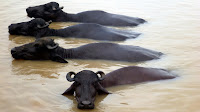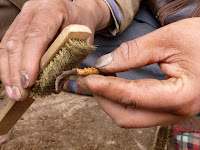Surprise!!
We decided to exchange our bikes for a 500cc Royal Enfield motorbike!
We decided to exchange our bikes for a 500cc Royal Enfield motorbike!
 |
| On our Royal Enfield at the India Gate in Delhi |
There are a couple of reasons for changing our form of transport:
We want to stop sweating all day, relax a bit & start our holidays – being able to spend more time in the places we visit;
As it’s monsoon season we want to reach our destination faster, before the daily 4pm rain showers;
Our budget is running low so we won’t be going to South America as planned & instead will be spending longer touring India, thereby covering greater distances, which are too long to do safely by bicycle;
By travelling greater distances daily we then know where we’re sleeping before it gets dark, unlike when we were cycling;
We want to feel safer in the chaotic Indian traffic, so have moved to an upper caste now; from “touchables” to Enfielders;
We still have a few 5000m+ mountain passes to cross on our way to Leh, so adventures are guaranteed!
We want to stop sweating all day, relax a bit & start our holidays – being able to spend more time in the places we visit;
As it’s monsoon season we want to reach our destination faster, before the daily 4pm rain showers;
Our budget is running low so we won’t be going to South America as planned & instead will be spending longer touring India, thereby covering greater distances, which are too long to do safely by bicycle;
By travelling greater distances daily we then know where we’re sleeping before it gets dark, unlike when we were cycling;
We want to feel safer in the chaotic Indian traffic, so have moved to an upper caste now; from “touchables” to Enfielders;
We still have a few 5000m+ mountain passes to cross on our way to Leh, so adventures are guaranteed!
 |
| Hot dogs in Rishikesh |
 |
| The joy of seeing the locals who gather around & watch us on our bicycle breaks |
Incredible India
 In India the traffic is the scariest. Whilst cycling, some guys on motorbikes
have pulled up right beside us to try to engage in conversation – stopping all
traffic behind them and creating a narrower & more dangerous cycling
situation for us. Some guys have tried, & some have even succeeded, in
stroking me as they ride on by. Another guy wanted Sertx’s autograph for some
unknown reason, and chased after us for a while. In Nepal we were continuously
asked ‘where from?’ whereas in India we are asked ‘Where are you
going to?’ We receive attention & help wherever we go; when we stop to
catch a bite for lunch, the locals slowly stop what they’re doing & start
crowding around us to stare at what we’re doing. When lost or when the
motorbike has broken down in the mountains, in the middle of nowhere, people
still manage to appear and offer all their time and endless efforts in helping
us.
In India the traffic is the scariest. Whilst cycling, some guys on motorbikes
have pulled up right beside us to try to engage in conversation – stopping all
traffic behind them and creating a narrower & more dangerous cycling
situation for us. Some guys have tried, & some have even succeeded, in
stroking me as they ride on by. Another guy wanted Sertx’s autograph for some
unknown reason, and chased after us for a while. In Nepal we were continuously
asked ‘where from?’ whereas in India we are asked ‘Where are you
going to?’ We receive attention & help wherever we go; when we stop to
catch a bite for lunch, the locals slowly stop what they’re doing & start
crowding around us to stare at what we’re doing. When lost or when the
motorbike has broken down in the mountains, in the middle of nowhere, people
still manage to appear and offer all their time and endless efforts in helping
us.
 In India the traffic is the scariest. Whilst cycling, some guys on motorbikes
have pulled up right beside us to try to engage in conversation – stopping all
traffic behind them and creating a narrower & more dangerous cycling
situation for us. Some guys have tried, & some have even succeeded, in
stroking me as they ride on by. Another guy wanted Sertx’s autograph for some
unknown reason, and chased after us for a while. In Nepal we were continuously
asked ‘where from?’ whereas in India we are asked ‘Where are you
going to?’ We receive attention & help wherever we go; when we stop to
catch a bite for lunch, the locals slowly stop what they’re doing & start
crowding around us to stare at what we’re doing. When lost or when the
motorbike has broken down in the mountains, in the middle of nowhere, people
still manage to appear and offer all their time and endless efforts in helping
us.
In India the traffic is the scariest. Whilst cycling, some guys on motorbikes
have pulled up right beside us to try to engage in conversation – stopping all
traffic behind them and creating a narrower & more dangerous cycling
situation for us. Some guys have tried, & some have even succeeded, in
stroking me as they ride on by. Another guy wanted Sertx’s autograph for some
unknown reason, and chased after us for a while. In Nepal we were continuously
asked ‘where from?’ whereas in India we are asked ‘Where are you
going to?’ We receive attention & help wherever we go; when we stop to
catch a bite for lunch, the locals slowly stop what they’re doing & start
crowding around us to stare at what we’re doing. When lost or when the
motorbike has broken down in the mountains, in the middle of nowhere, people
still manage to appear and offer all their time and endless efforts in helping
us.
So far we have visited Varanasi, known for the
rituals & ceremonies taking place at & in the Ganges river;
 |
| bathing water buffalos |
New Delhi, the bustling
capital;
 |
| Lotus Temple in Delhi |
Rishikesh, the yoga capital of
the world made famous by the Beatles;
 |
| Kali goddess statue in Rishikesh |
Mussoorie, a crowded yet
beautiful 2000m high mountain resort &
 |
| arriving in busy Mussoorie |
 |
| Sertx in the Rock Garden in Chandigarh |
India has the most delectably flavoured food & sweets,
and the flies that share our meals think the same too! We pass monkeys,
elephants, goats, buffalos & holy cows on the roads every day. Every corner
is full of surprises. India is an incredible country!





















